SOLD
End of 19th Century Hand Woven Pure French Linen Made Antique Chore Work Worker Paysan Coat
フランスの農村部などで作られた古い仕事着には、一般的にイメージされるフレンチワークウェアとは別の魅力が溢れています。
Old work clothes made in the rural areas of France have a different appeal from the French work wear that is generally imagined.
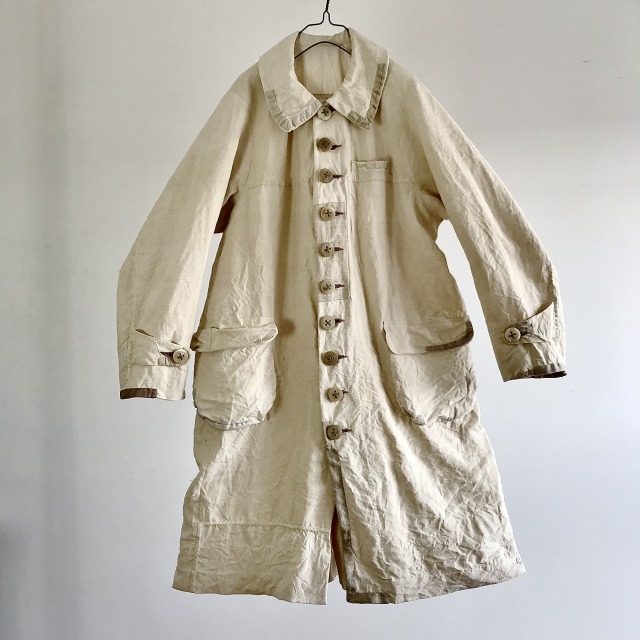
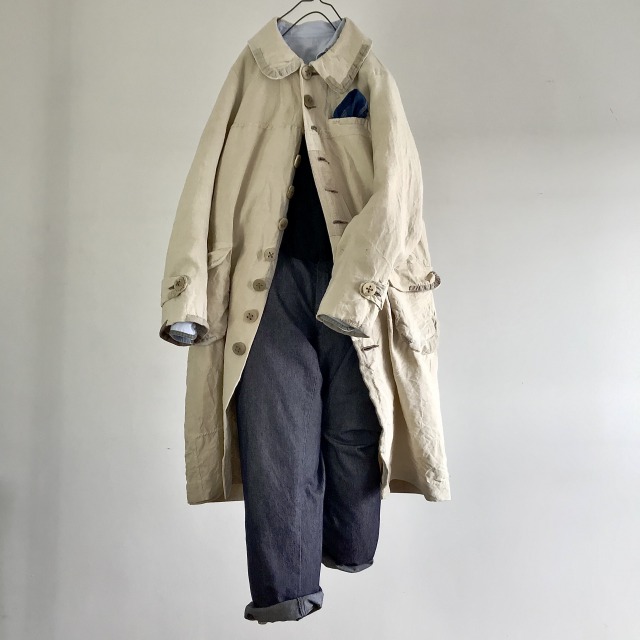
19世紀末頃から、都市部とその近郊地域での産業や商業の発展とともに発達し、産業革命や近代化の結晶としてのワークウェアは、服飾知識と技術を持った専門家によるデザインとパターン製作や、縫製や工程の管理を基本とした、ワークウェア自体が立派な商品となる工業生産品でした。特にフランスのものは、テーラーワークを基本にしたパターンと縫製が作り出す立体的で曲線的なデザインと、ホワイトとグレーのメランジ糸の生地(salt&pepper)など、雰囲気溢れる表情が今でも独特の魅力を持っています。
From the end of the 19th century, workwear developed along with the development of industry and commerce in urban and suburban areas, and as a crystallization of the Industrial Revolution and modernization, workwear was an industrial product that was itself a fine product, based on design and pattern making by experts with clothing knowledge and skills, and sewing and process control. Workwear itself was an industrial product that became a respectable commodity.
In particular, French workwear still has a unique appeal with its three-dimensional and curvy design created by tailor-made patterns and sewing, as well as its atmospheric expressions such as white and gray melange yarn fabric (salt&pepper).
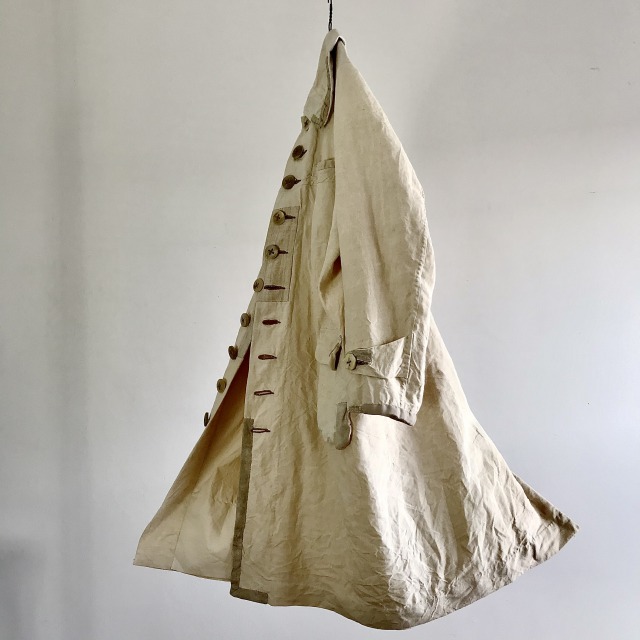
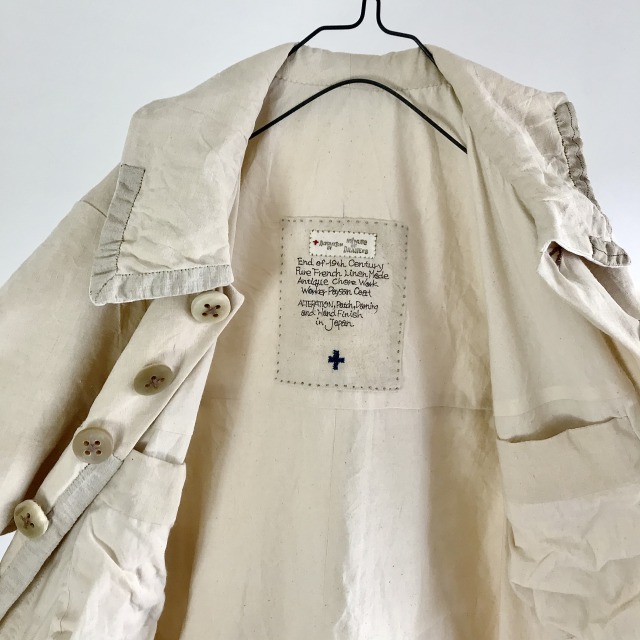
一方、周辺の農村部などでは、生活や仕事着が近代化されるのは1900年代の中期以降でした。今も食糧自給率が120%を超え、欧州連合(EU)一の農業生産国のフランスには、民族衣装から発展し、牧畜に従事する人々が作り上げたBiaudeや、農家の室内着や寝間着になったスモックなど豊かな感性に彩られたフランス独自の様々な衣料や仕事着が自らの手や町の仕立て屋で手作りされていました。
On the other hand, in the surrounding rural areas, life and work clothes were not modernized until the mid-1900s. In France, which still has a food self-sufficiency rate of over 120% and is the largest agricultural producer in the European Union (EU), a variety of clothing and work clothes unique to France were hand-made by the people themselves or by tailors in the towns. These clothes were made by hand or by local tailors.
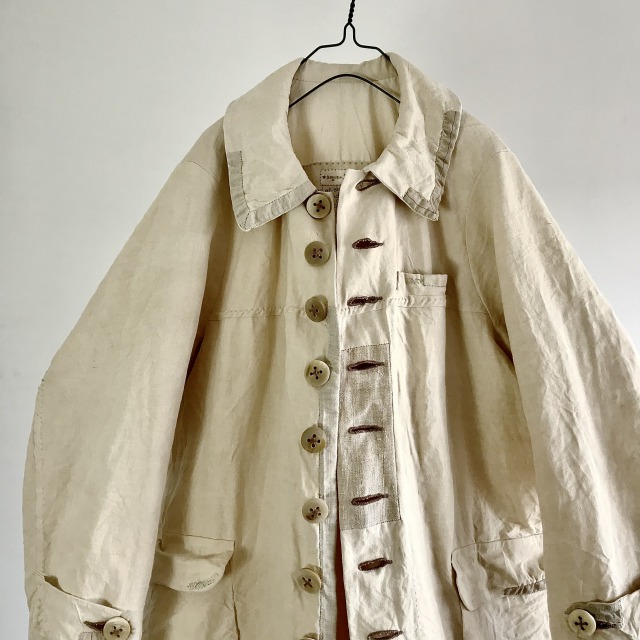
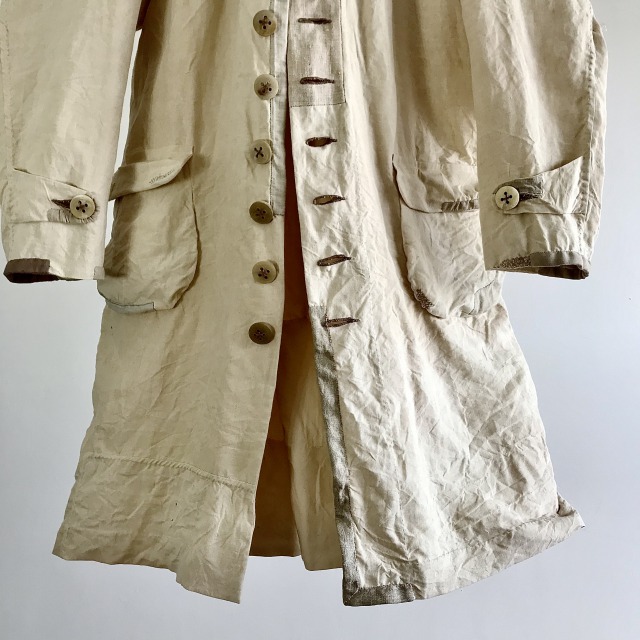
フランスのスモックやBiaudeは、出来上がった物を購入するだけではなく、農家の奥さんなどが、昔から受け継がれてきた物を見本に作り続けて来たものも多くあります。体に沿う立体的な形にするためのパターンなどの、服飾に対する専門的な知識が発達する以前から引き継がれてきた原型は、生地をできるだけ無駄なく使い、縫製も容易な直線で構成されたパーツを組み合わせた、ユニークな仕様で作られています。
In France, smocks and biaudes are not only purchased ready-made, but also made by farmers’ wives, who have continued to make them based on samples passed down from generation to generation. The prototypes, which have been handed down since before the development of specialized knowledge of clothing, such as patterns to create a three-dimensional shape that follows the body, are made to unique specifications, using as little fabric as possible and combining parts made up of straight lines that are easy to sew.
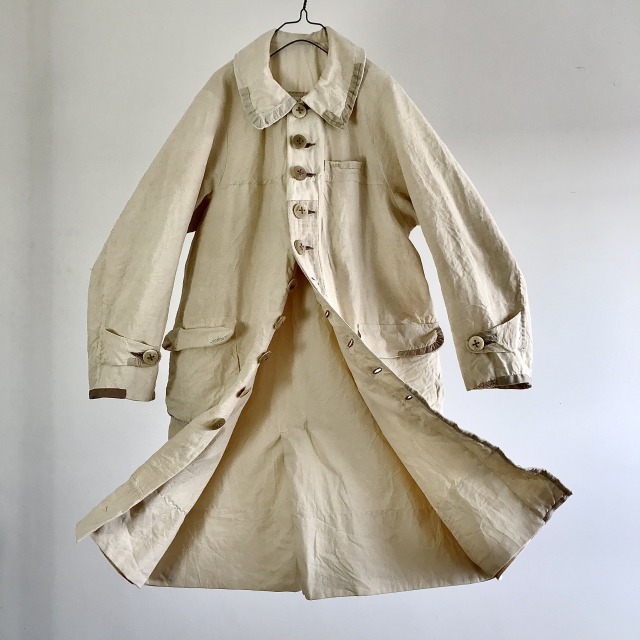
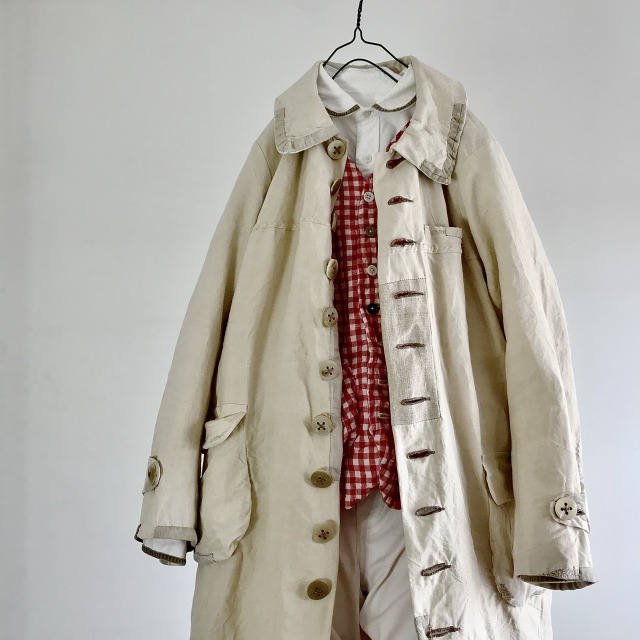
このコートは、19世紀末から20世紀初頭の頃に見られたものの一つで、直線の四角形のパーツばかりを使って、ギャザーでボリュームと運動量を確保した農家手作りのスモックと、テーラーの流れを取り入れた工業製品でありプロフェッショナルメイクのワークウェアの過渡期だったことを暗示するようなユニークな組み合わせで仕立てられています。
This coat is one of those seen around the end of the 19th century and the beginning of the 20th century. It is a combination of a farmer’s handmade smock with all straight rectangular parts and gathers for volume and movement, and an industrial, professionally made workwear with a tailor’s flow.
It is tailored in a unique combination that suggests that this was a transitional period for professional workwear.
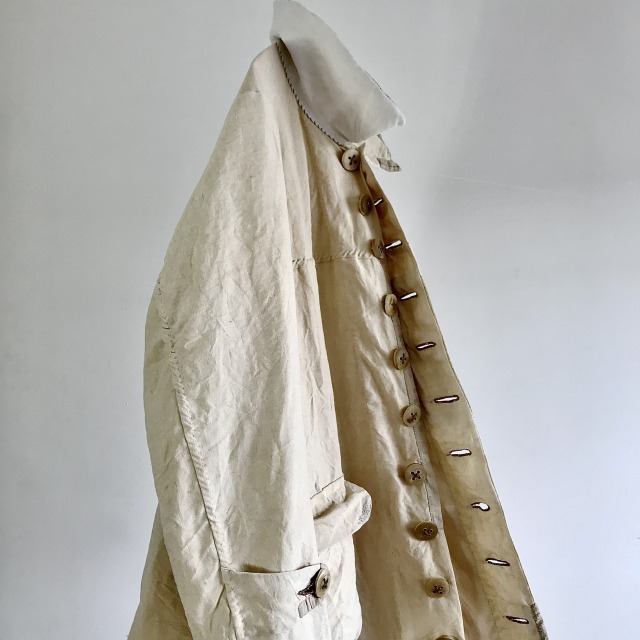
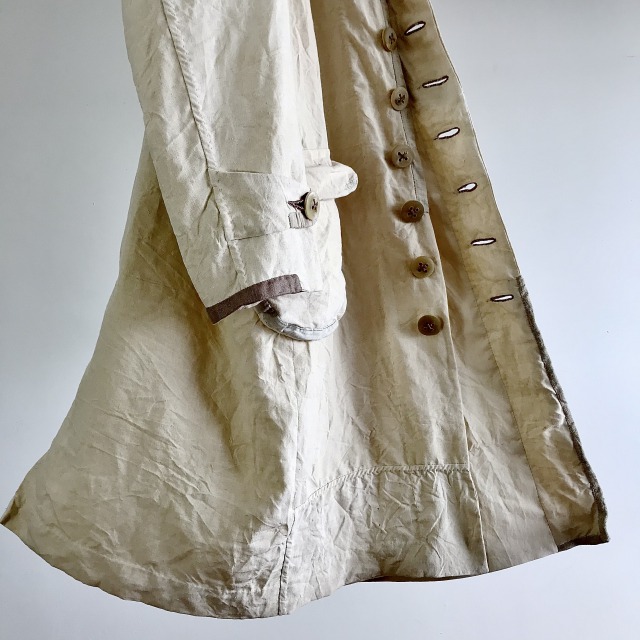
世界一のリネン大国のフランスならではのリネンで仕立てられたワークコートです。立体的なデザインとパターンが、100年前の物とは思えない現代的な意外性に溢れています。
This is a work coat made of linen, which is unique to France, the world’s largest linen country. The three-dimensional design and pattern are full of modern unexpectedness that makes it hard to believe it is 100 years old.
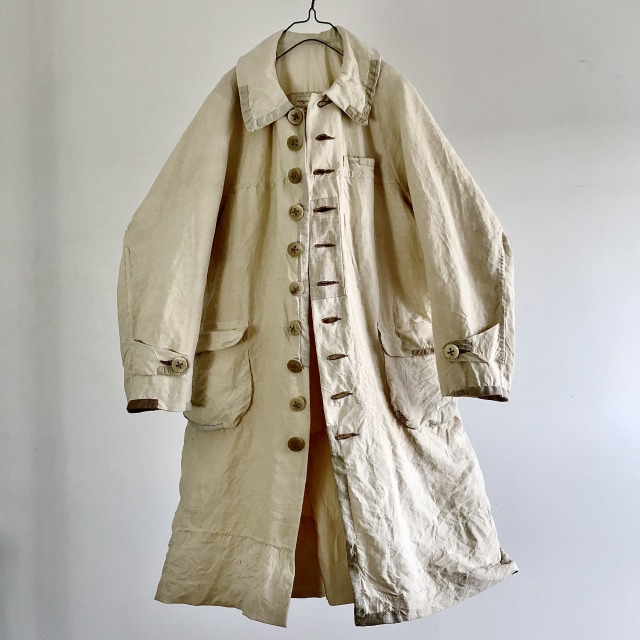
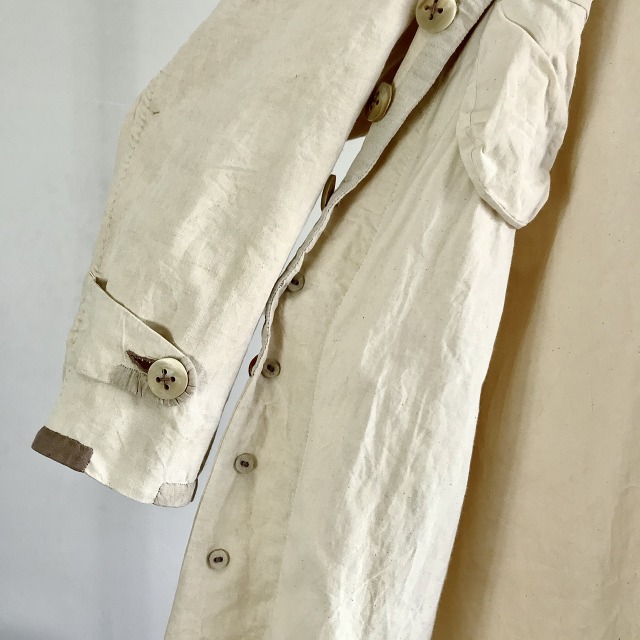
肩ヨークが接ぎの無い1枚仕立ての特殊な仕様で、とても珍しい造りで作られたコート。背中の接ぎを経地に合わせたヨークが、体に沿って前に回り込んでくるにつれて、しだいに生地方向が変化し、肩から胸にかけてがバイアス方向の生地使いとなり、肩の傾斜に馴染むとともに、腕の動きにも沿う伸縮性を持った、とても理にかなった作りです。
This is a very rare coat with a special specification of a single piece of tailoring without grafted shoulder yokes. The yoke, which is glued at the back to the warp fabric, gradually changes the direction of the fabric as it goes around the front along the body, and from the shoulders to the chest, the fabric is used in a bias direction, which fits the slope of the shoulders and has elasticity to follow the movement of the arms.
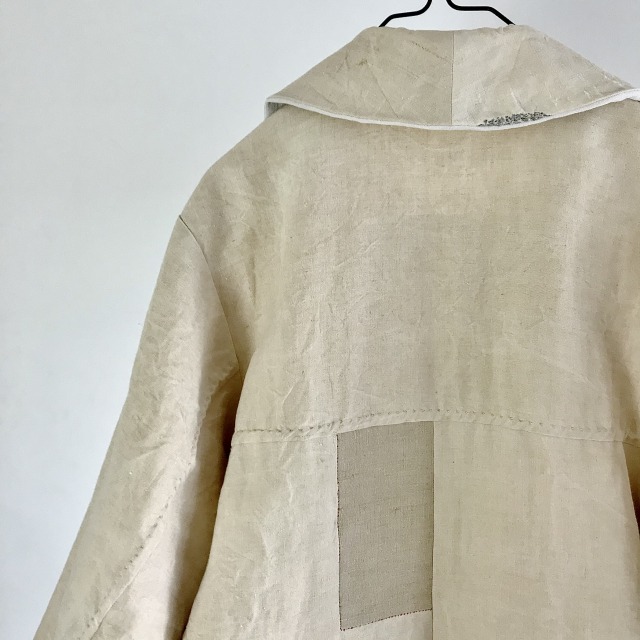
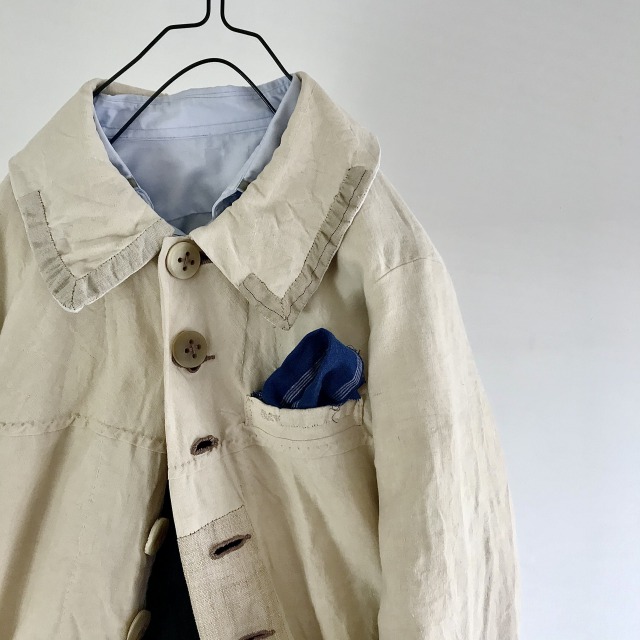
ナチュラルな肩のフォルムを作り出し、広い身幅と肩をバランスよく繋ぐパターンはフランスならではの発想だと思います。
The pattern that creates a natural shoulder form and connects the wide body and shoulders in a well-balanced way is a unique French idea.
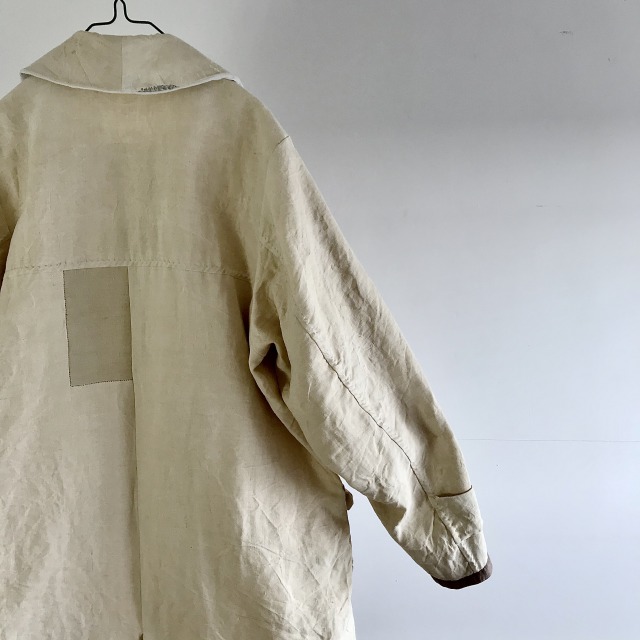
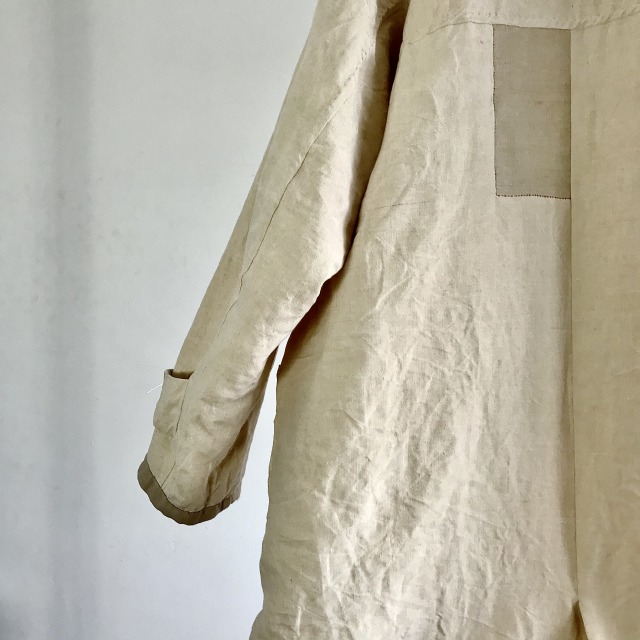
胸から下の身頃は、前身頃から背中心までを1枚で作り背中で繋いだたとてもユニークな設計。脇に接ぎがなくたっぷりとした身幅から裾に向かって緩やかに広がるシルエットは、比較的コンパクトな肩とのバランスの対比がユニークな味わいを深めてくれます。
The body from the chest down is made in one piece from the front to the center of the back and connected at the back, a very unique design. The silhouette spreads gently from the generous width of the body to the hem without any grafting at the sides, and the contrast in balance with the relatively compact shoulders deepens the unique flavor.
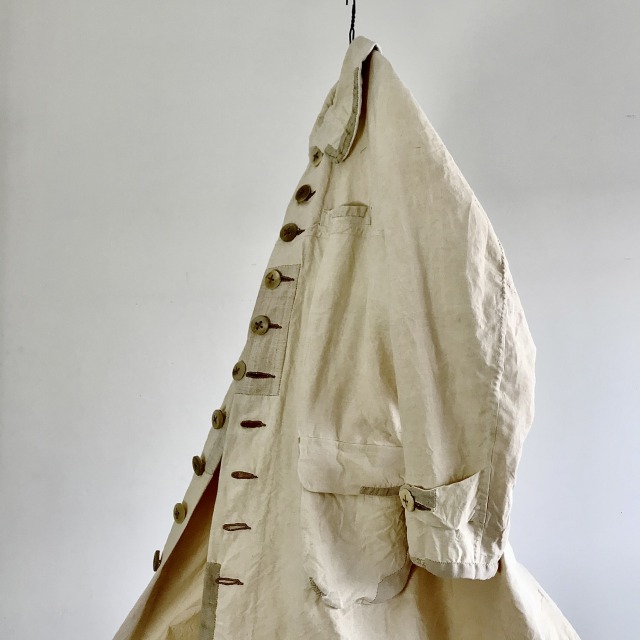
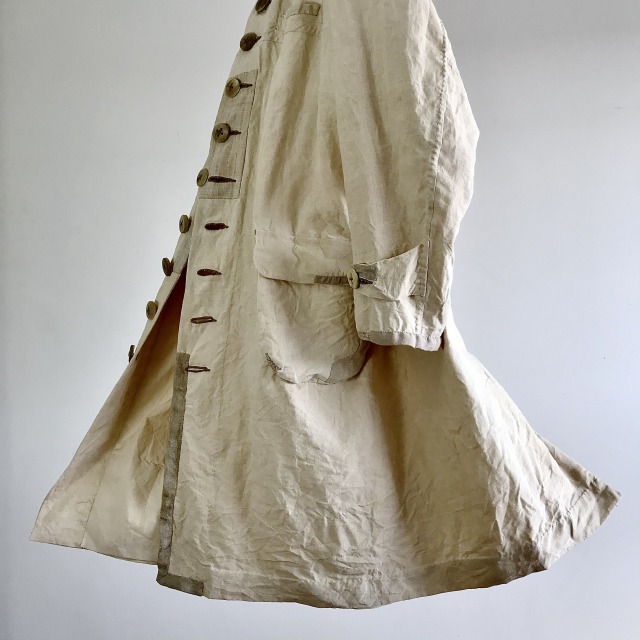
ユニークで立体的な発想の肩ヨークに、生地の横幅をそのまま利用して無駄なく生地を使って、繋ぎ合わせただけのまっすぐな身頃を合わせた面白い仕立て。ここに腕に沿った曲線を描く2枚袖の腕と、このころの特徴的なフラットな衿といった組み合わせ。
The shoulder yoke, a unique and three-dimensional idea, is combined with a straight body that is simply pieced together, using the width of the fabric as it is and without wasting any fabric. The combination of the two-piece sleeves that curve along the arms and the flat collar that is characteristic of these days.
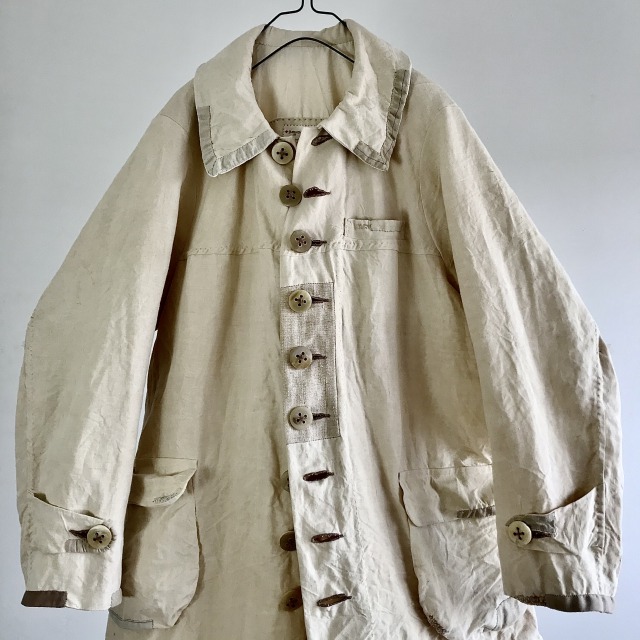
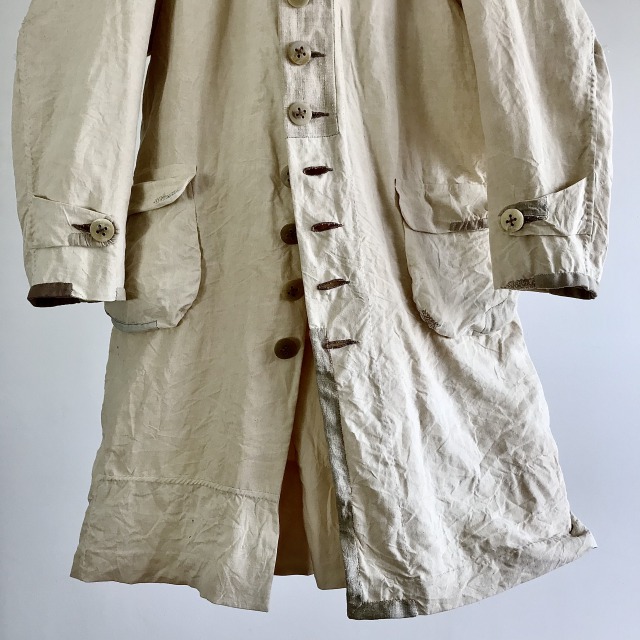
このころのフランスの仕事着によく見られる、衿を1枚で作らずに強くカーブした2枚のパーツを継いだ、身頃に沿う形のフラットながらもボリュームのある衿。この衿も立体的なパターン発想が作り出したフランスならではのもの。衿裏は、フランスのアンティークベッドリネンに張り替えています。
A flat but voluminous collar that follows the body, made of two strongly curved pieces joined together instead of a single collar as was common in French work clothes of the time. This collar is also unique to France, created by the idea of a three-dimensional pattern. The back of the collar has been reupholstered in antique French bed linen.
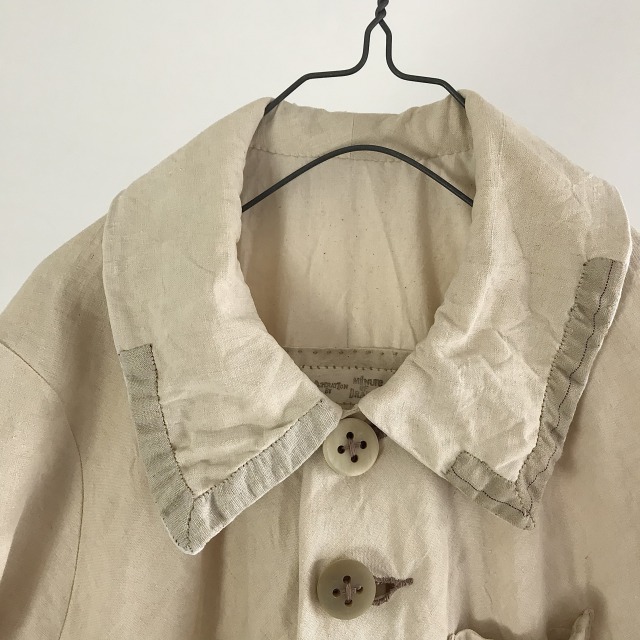
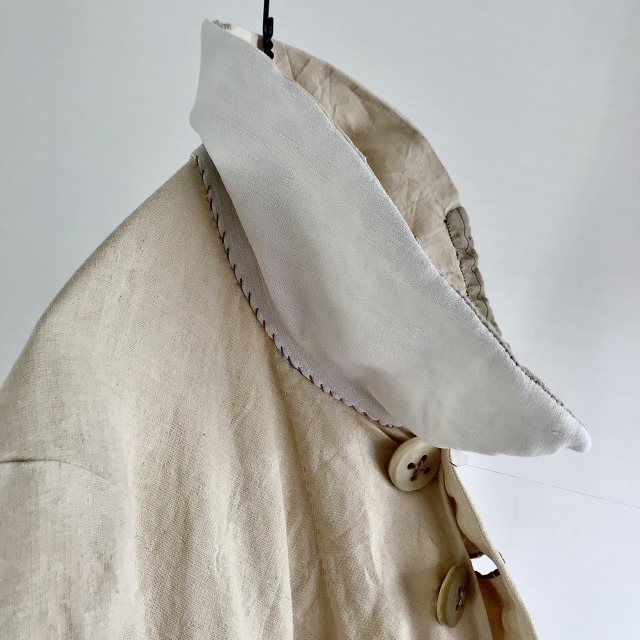
着込まれたダメージ痕を補修したpatchとdarning。手で丹念にかがりつけたステッチや、意図しては作れない痕跡は、偶然と時間と人の手が紡ぎ出したものです。
Patch and darning with worn-in damage repaired, stitches painstakingly crocheted by hand, and traces that cannot be created intentionally are the result of chance, time, and human hands.
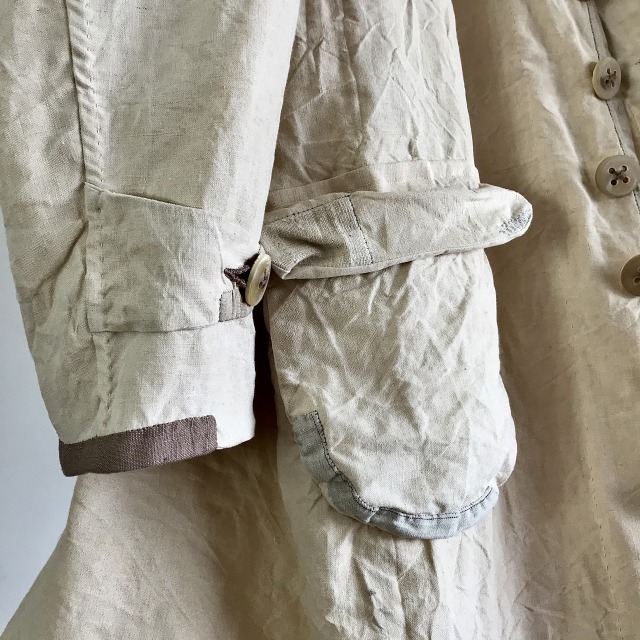
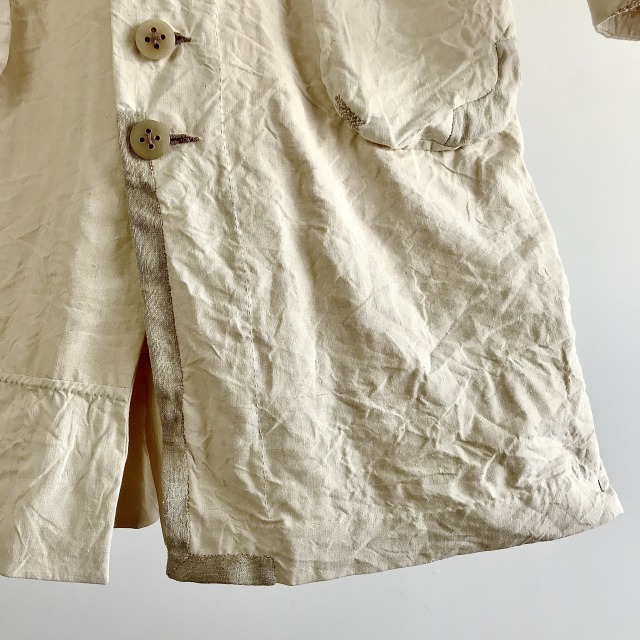
前たての見返しや裾のハンドステッチが作る柔らかな陰影。多くを職人の手作業と勘で支えられていた時代の、紡糸と手動織機で織られた生地の、独特の表情と味わいが滲み出る生地。
The soft shade created by the hand stitching on the front facing and hem. This fabric exudes the unique expression and flavor of a fabric woven with spun yarn and manual looms in an era when much of the work was done by hand and intuition.
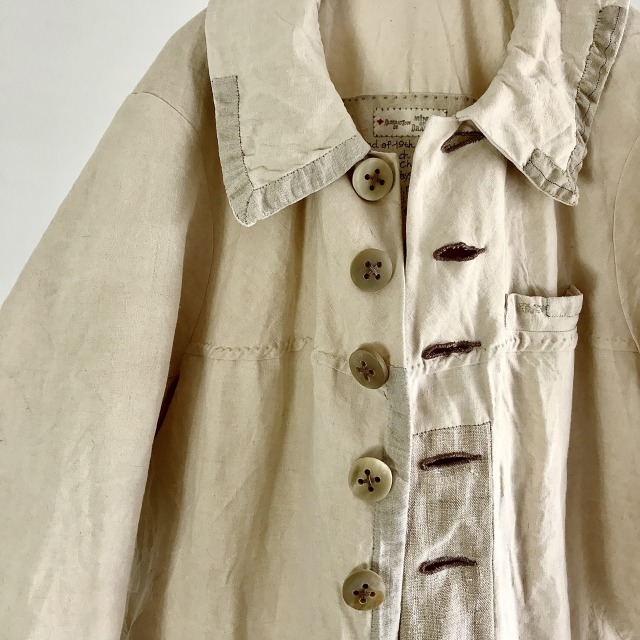
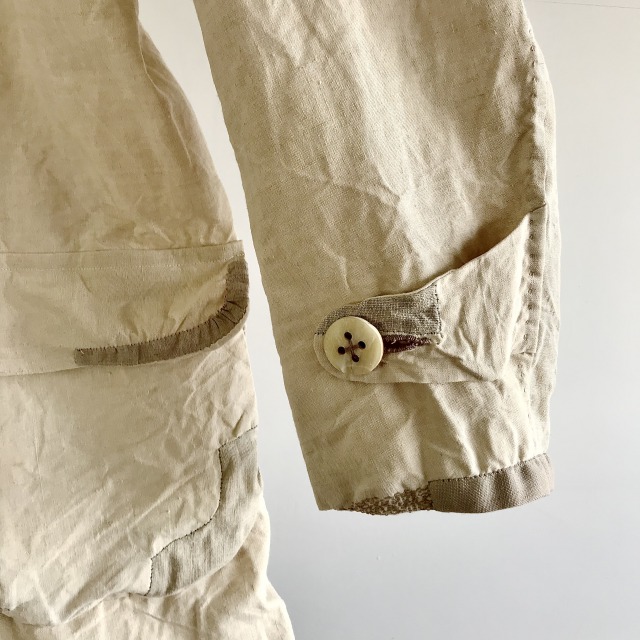
しっかり着込まれた年月の経過を映す枯れた質感と色合いが入り混じる生地は、リネン大国フランスならではの軽い風合いのリネン。グレーがかったベージュのイメージが強いフラックス(亜麻)の素の色(=ecru=生成り=生成りと言う色の名前は日本で亜麻の色を表すために作られた色名)ですが、この生地は美しいライトベージュです。
The fabric, with its withered texture and colors that reflect the passage of time, is a light-textured linen that can only be found in France, the land of linen. The original color of flax (=ecru = KINARI = the color name was created in Japan to describe the color of flax) has a strong image of grayish beige, but this fabric is a beautiful light beige.
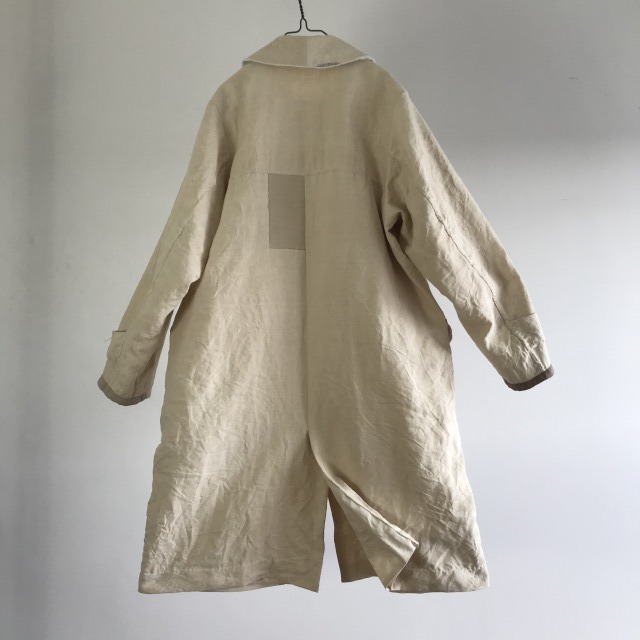
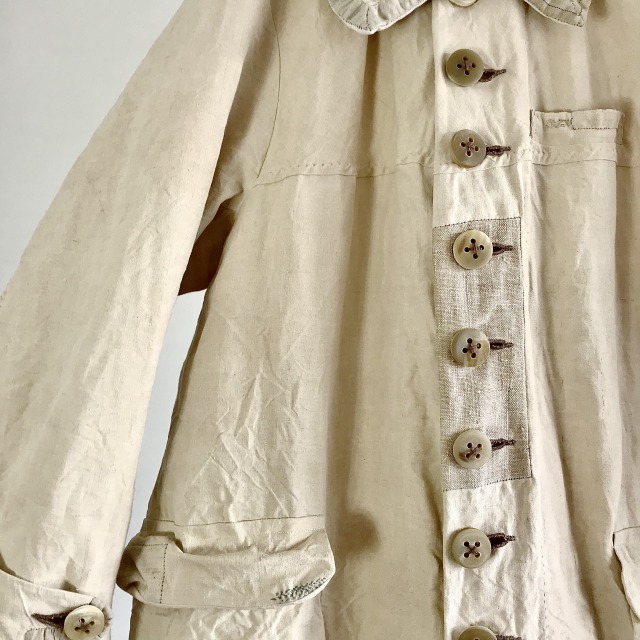
大きめだったポケットはダメージを補修し、フォルムを少し変えて裏に生地をつけて丸く立体感のあるポケットに。フラップや袖のタブもダメージの補修と裏地を変更。
The large pockets have been repaired, and the shape of the pockets has been slightly changed and lined with fabric to give them a round, three-dimensional appearance. The tabs on the flaps and sleeves have also been repaired and lined.
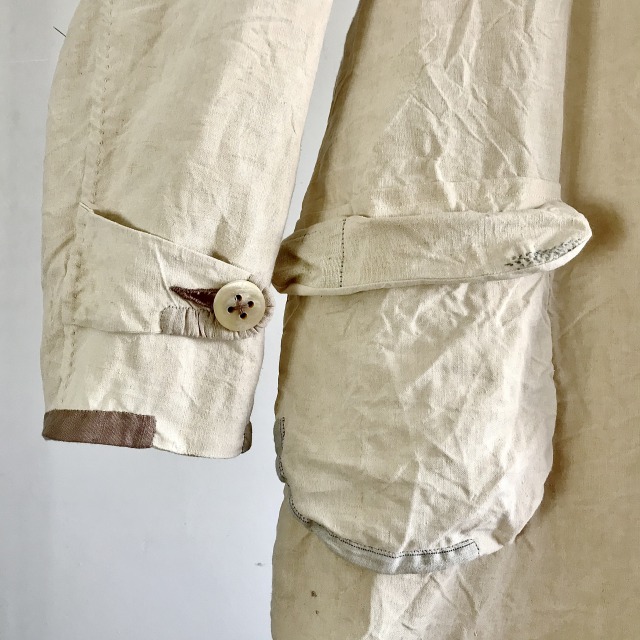
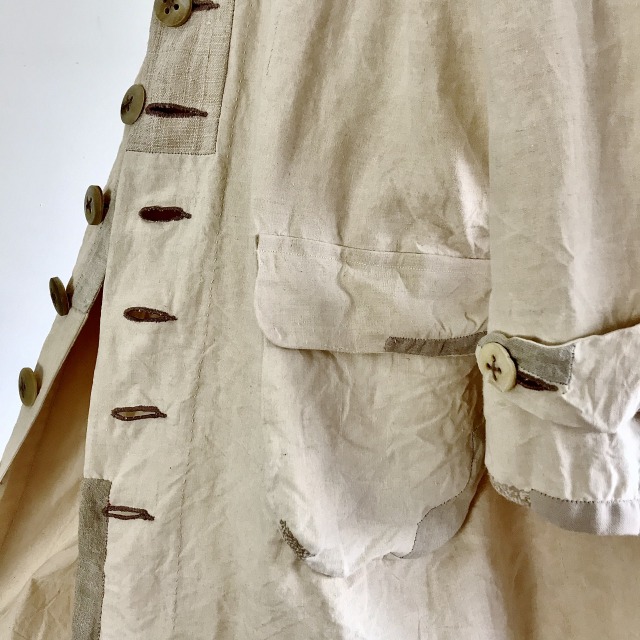
ヘムを軽くするために表地から浮かせてつけたライニングの裾。適度なボリュームを持たせるために深い見返しをつけ、ハンドステッチでアクセントを添えています。
The hem of the lining is floated from the outer fabric to lighten the hem. A deep turnover is added to give the right amount of volume, and hand-stitched accents are added.
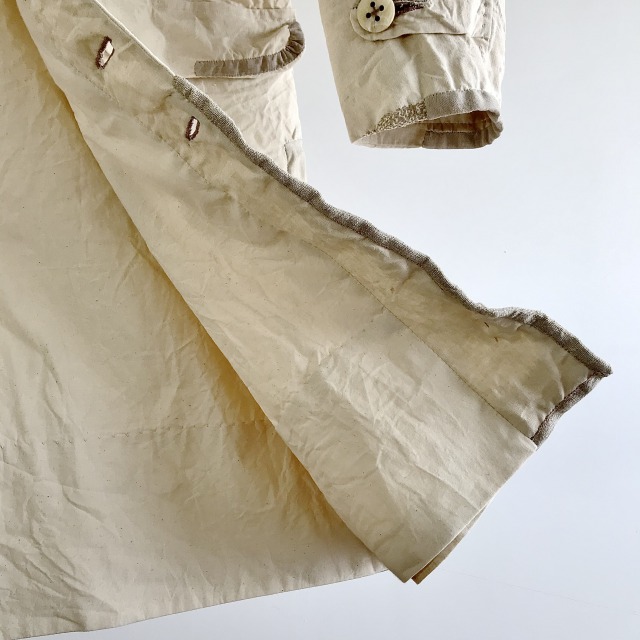
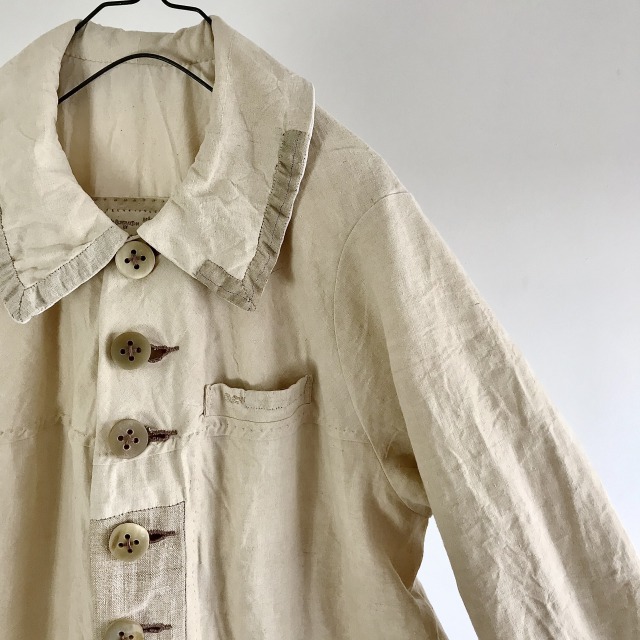
ライニングを縫い合わせる手仕事によるブラインドステッチ。ミシンで縫えば数分の仕事に、その十数倍の時間をかけたことの意味は、きっとあるはず。
Blind stitching by hand to sew the linings together. It must be meaningful that we spent more than ten times as much time on a job that would take only a few minutes if sewn with a sewing machine.
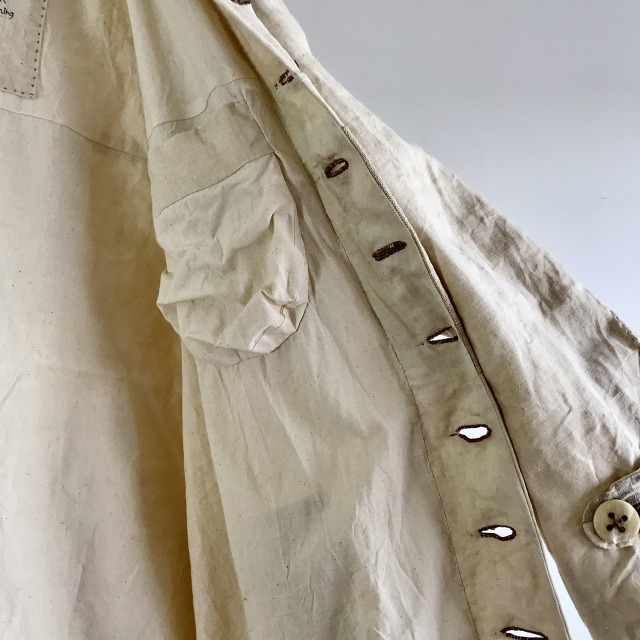
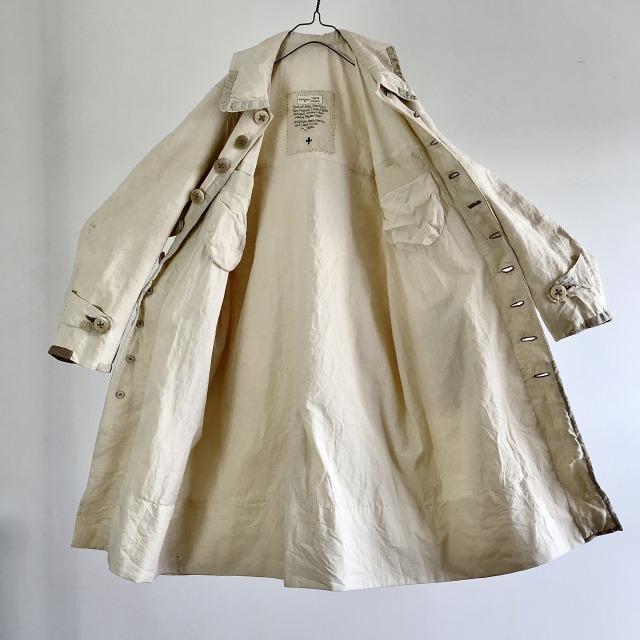
ボタンは英国の1950-1960年代のVintageのデッドストックです。通常に見られる角のボタンのほとんどは水牛の角から作られているもので、主としてアジア圏の水牛の角をアジア圏で加工したものです。このボタンは、英国の有名紳士服ブランドの注文により特別に作られた、英国の牛(ヘレフォードやアバディーンアンガス)の角を使って英国で作られたものです。
The buttons are British 1950s-1960s vintage dead stock. Most horn buttons normally found are made from buffalo horn, mainly from Asian buffalo horn, processed in Asia. This button was made in England from the horn of a British cow (Hereford or Aberdeen Angus), specially made to order for a famous British menswear brand.
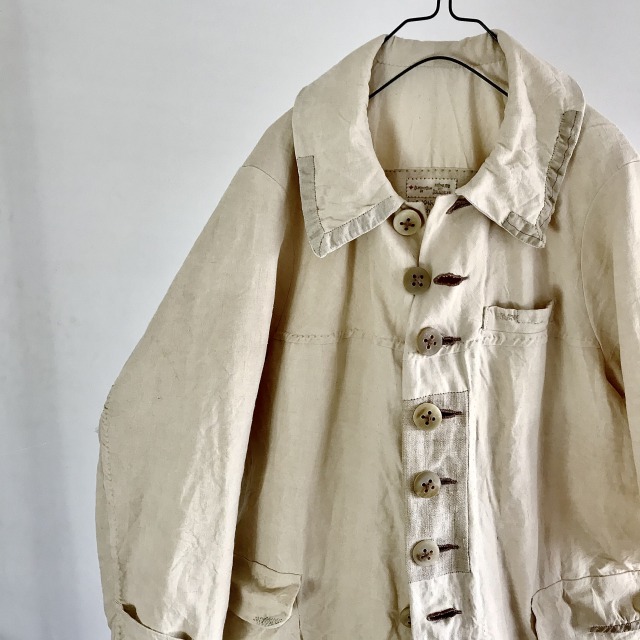
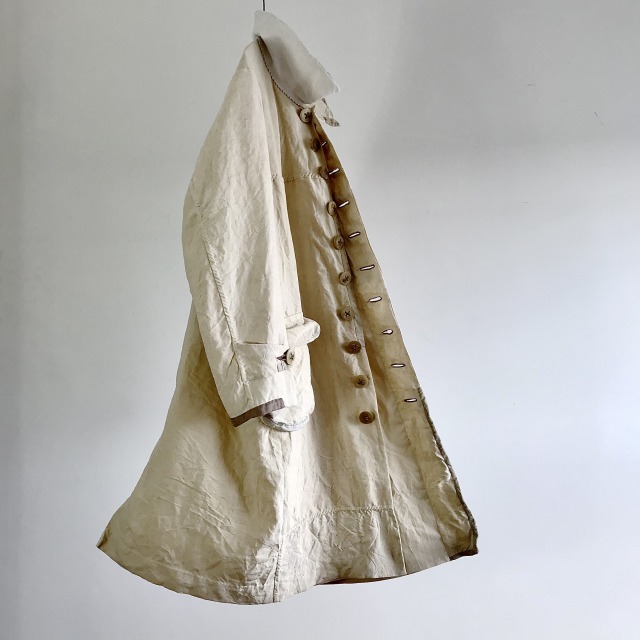
4-6mmという厚み、裏側の皮付き仕上げ、ブラウン、ブラック、乳白、透け感のあるベージュと濁ったベージュなどが自然に入り混じった角の色合い、27mmという大きさ、モダンな印象をも感じさせる、間隔が広く大きな穴の4つのボタン穴、丸く切り出した形を粗く削っただけで素のままの表情を活かした風合い、どこを取っても迫力と良さしかない60年以上も前の貴重で珍しい逸品のボタンです。
The thickness of the button is 4-6mm, the leather finish on the back side, the color of the corners is a natural mixture of brown, black, milky white, translucent beige and muddy beige, the size of the button is 27mm, the four button holes are widely spaced and large, giving a modern impression, and the shape was cut out in a round shape and roughly shaved. It is a precious and rare gem of a button from more than 60 years ago that has nothing but power and goodness no matter where you take it.
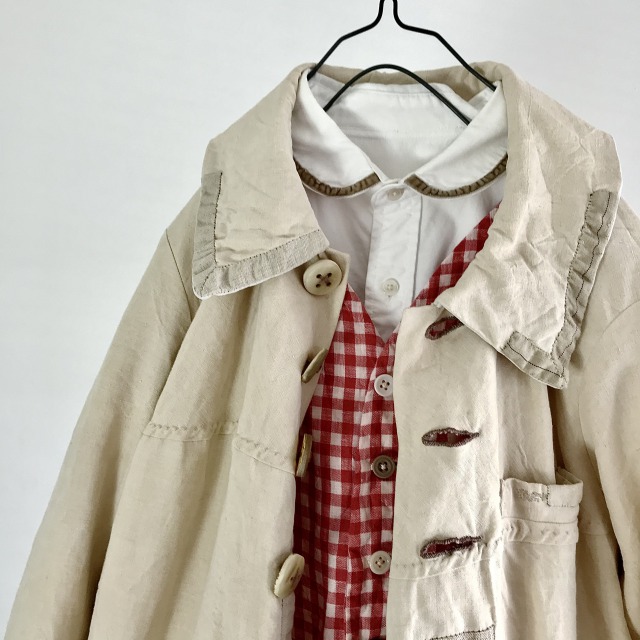
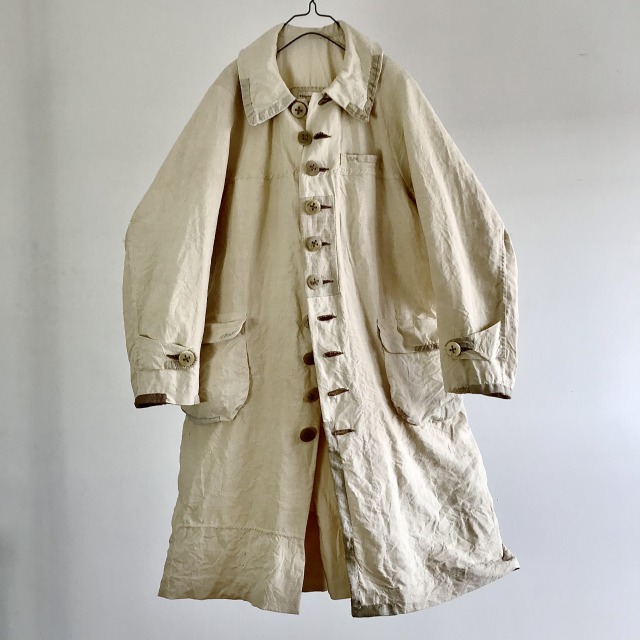
胸ポケットの袋布もrustic cottonで作り直しています。長い時間のこびりついた得体の知れない埃や糸くずは取り除くのがお約束。
The sackcloth for the breast pocket is also remade in rustic cotton. I promised to remove the unidentifiable dust and lint that has stuck to the fabric for a long time.
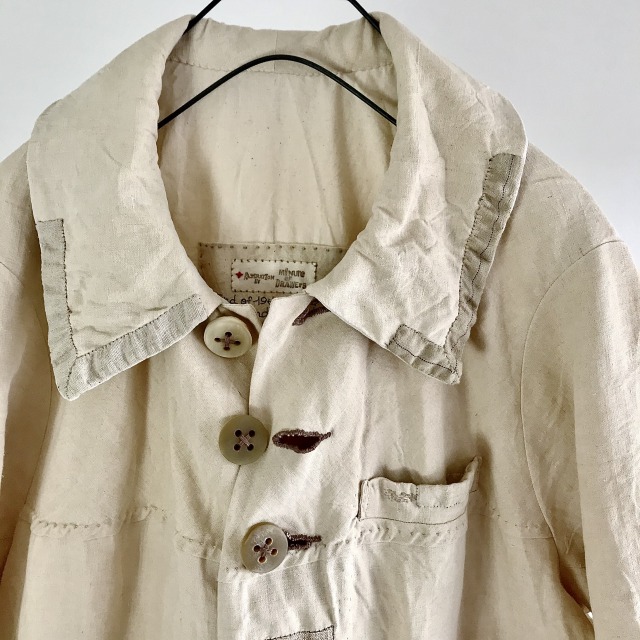
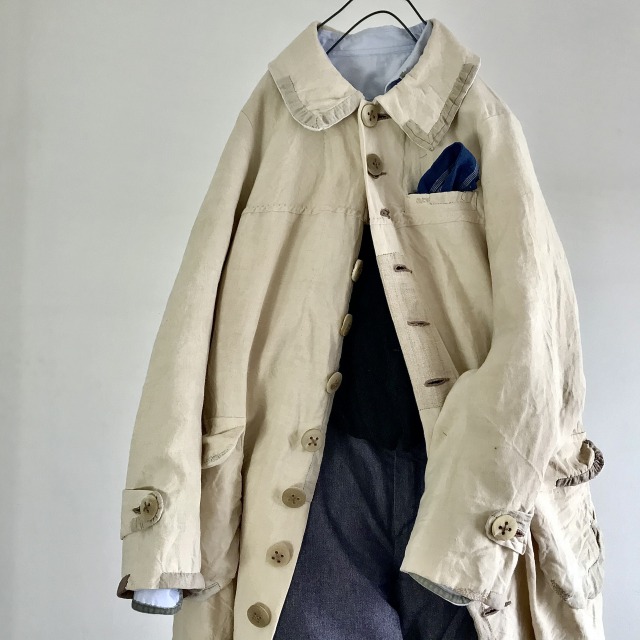
糸が解けたり破れのあったボタンホールを、数を増やして全てリネンコードで作り直し、存在感のあるボタンがずらりと並ぶ迫力のある顔立ちに。
The buttonholes, which had unraveled threads or were torn, were remade with a larger number of linen cords to create a powerful look with a row of buttons with a strong presence.
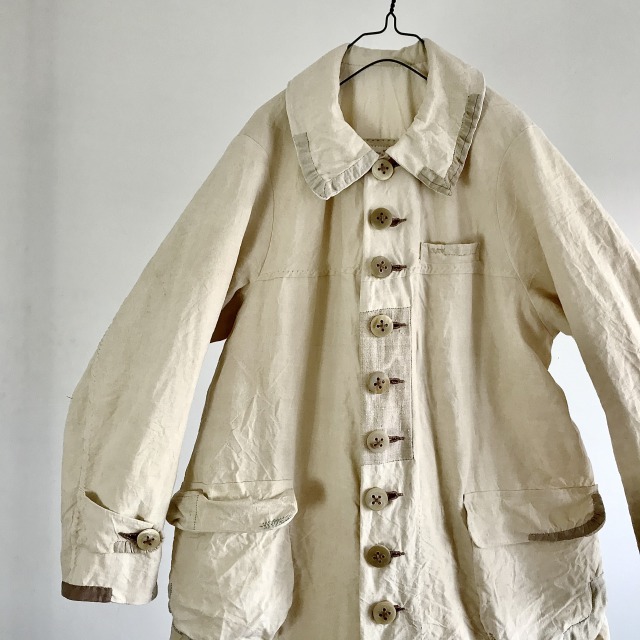
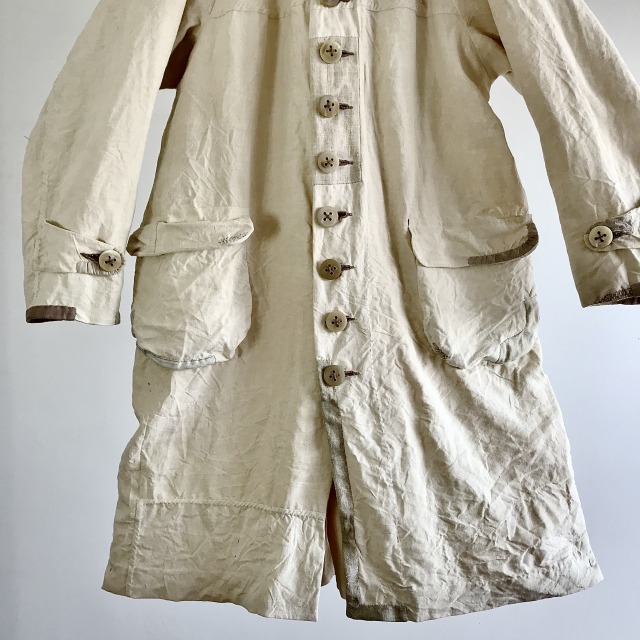
長い時間を経てきたものへの憧憬を形作り、経てきた時間の表情を加工で作り出してまとった表層的な作り物ではなく、この1枚は、本当に長い時間を経過した痕跡を凝集した本物と、現代性の融合を形にした一着です。
This piece is not a superficial creation that has been created by processing the expression of time that has passed, but a fusion of authenticity and modernity that has gathered the traces of time that has truly passed.
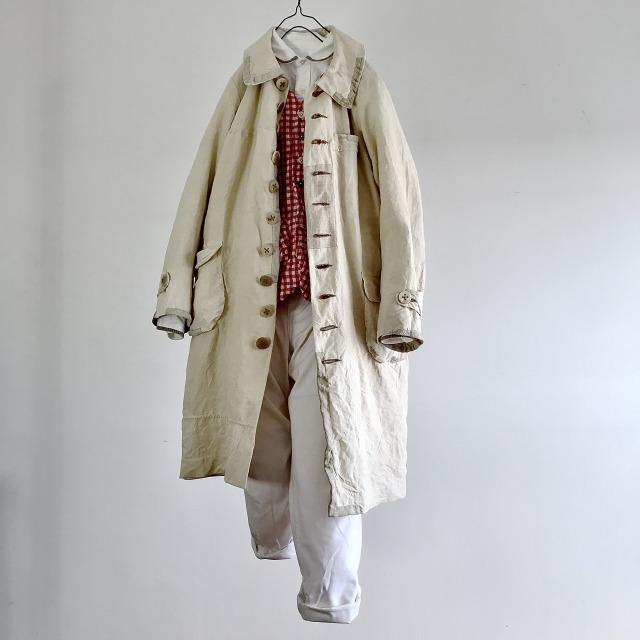
サイズ 2
肩幅 = 45cm
バスト= 60cm (脇下)
袖丈 = 62cm
着丈 = 107cm
フランス/日本製
Front Fabric =Hand Woven Pure French Linen/ Linen 100%
Back Fabric =Indian Rustic Cotton Broad Cloth / Cotton100%
Buttons =1950-1960 Vintage French Cow Horn Button
& Antique Fabric Covered Button
STOREへのリンク
End of 19th Century Hand Woven Pure French Linen Made Antique Chore Work Worker Paysan Coat
[ALTERATION By Manure Of Drawers] SOLD

